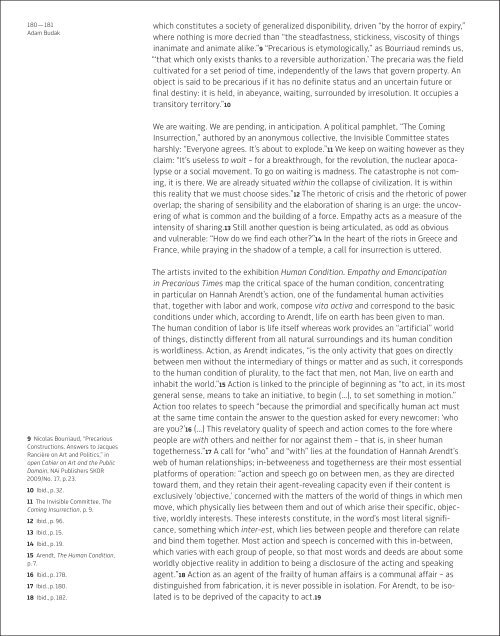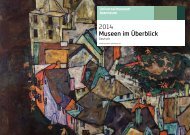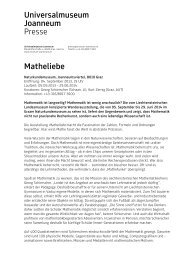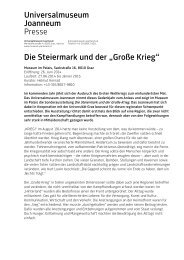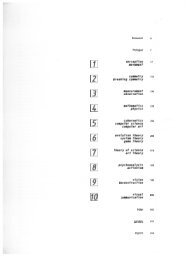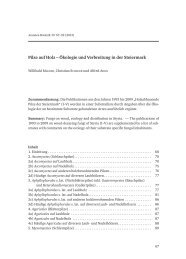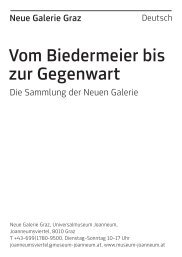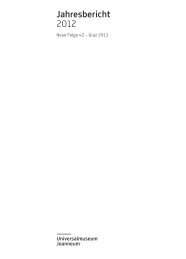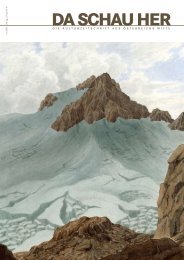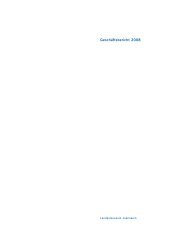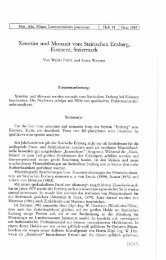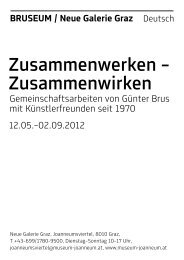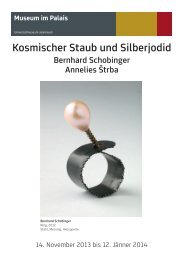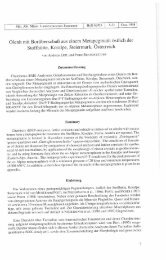Human Condition - Universalmuseum Joanneum
Human Condition - Universalmuseum Joanneum
Human Condition - Universalmuseum Joanneum
Erfolgreiche ePaper selbst erstellen
Machen Sie aus Ihren PDF Publikationen ein blätterbares Flipbook mit unserer einzigartigen Google optimierten e-Paper Software.
180 — 181<br />
Adam Budak<br />
9 Nicolas Bourriaud, “Precarious<br />
Constructions. Answers to Jacques<br />
Rancière on Art and Politics,” in<br />
open Cahier on Art and the Public<br />
Domain, NAi Publishers SKOR<br />
2009/No. 17, p. 23.<br />
10 Ibid., p. 32.<br />
11 The Invisible Committee, The<br />
Coming Insurrection, p. 9.<br />
12 Ibid., p. 96.<br />
13 Ibid., p. 15.<br />
14 Ibid., p. 19.<br />
15 Arendt, The <strong>Human</strong> <strong>Condition</strong>,<br />
p. 7.<br />
16 Ibid., p. 178.<br />
17 Ibid., p. 180.<br />
18 Ibid., p. 182.<br />
which constitutes a society of generalized disponibility, driven “by the horror of expiry,”<br />
where nothing is more decried than “the steadfastness, stickiness, viscosity of things<br />
inanimate and animate alike.”9 “Precarious is etymologically,” as Bourriaud reminds us,<br />
“‘that which only exists thanks to a reversible authorization.’ The precaria was the field<br />
cultivated for a set period of time, independently of the laws that govern property. An<br />
object is said to be precarious if it has no definite status and an uncertain future or<br />
final destiny: it is held, in abeyance, waiting, surrounded by irresolution. It occupies a<br />
transitory territory.”10<br />
We are waiting. We are pending, in anticipation. A political pamphlet, “The Coming<br />
Insurrection,” authored by an anonymous collective, the Invisible Committee states<br />
harshly: “Everyone agrees. It’s about to explode.”11 We keep on waiting however as they<br />
claim: “It’s useless to wait – for a breakthrough, for the revolution, the nuclear apocalypse<br />
or a social movement. To go on waiting is madness. The catastrophe is not coming,<br />
it is there. We are already situated within the collapse of civilization. It is within<br />
this reality that we must choose sides.”12 The rhetoric of crisis and the rhetoric of power<br />
overlap; the sharing of sensibility and the elaboration of sharing is an urge: the uncovering<br />
of what is common and the building of a force. Empathy acts as a measure of the<br />
intensity of sharing.13 Still another question is being articulated, as odd as obvious<br />
and vulnerable: “How do we find each other?”14 In the heart of the riots in Greece and<br />
France, while praying in the shadow of a temple, a call for insurrection is uttered.<br />
The artists invited to the exhibition <strong>Human</strong> <strong>Condition</strong>. Empathy and Emancipation<br />
in Precarious Times map the critical space of the human condition, concentrating<br />
in particular on Hannah Arendt’s action, one of the fundamental human activities<br />
that, together with labor and work, compose vita activa and correspond to the basic<br />
conditions under which, according to Arendt, life on earth has been given to man.<br />
The human condition of labor is life itself whereas work provides an “artificial” world<br />
of things, distinctly different from all natural surroundings and its human condition<br />
is worldliness. Action, as Arendt indicates, “is the only activity that goes on directly<br />
between men without the intermediary of things or matter and as such, it corresponds<br />
to the human condition of plurality, to the fact that men, not Man, live on earth and<br />
inhabit the world.”15 Action is linked to the principle of beginning as “to act, in its most<br />
general sense, means to take an initiative, to begin (…), to set something in motion.”<br />
Action too relates to speech “because the primordial and specifically human act must<br />
at the same time contain the answer to the question asked for every newcomer: ‘who<br />
are you?’16 (…) This revelatory quality of speech and action comes to the fore where<br />
people are with others and neither for nor against them – that is, in sheer human<br />
togetherness.”17 A call for “who” and “with” lies at the foundation of Hannah Arendt’s<br />
web of human relationships; in-betweeness and togetherness are their most essential<br />
platforms of operation: “action and speech go on between men, as they are directed<br />
toward them, and they retain their agent-revealing capacity even if their content is<br />
exclusively ‘objective,’ concerned with the matters of the world of things in which men<br />
move, which physically lies between them and out of which arise their specific, objective,<br />
worldly interests. These interests constitute, in the word’s most literal significance,<br />
something which inter-est, which lies between people and therefore can relate<br />
and bind them together. Most action and speech is concerned with this in-between,<br />
which varies with each group of people, so that most words and deeds are about some<br />
worldly objective reality in addition to being a disclosure of the acting and speaking<br />
agent.”18 Action as an agent of the frailty of human affairs is a communal affair – as<br />
distinguished from fabrication, it is never possible in isolation. For Arendt, to be isolated<br />
is to be deprived of the capacity to act.19


